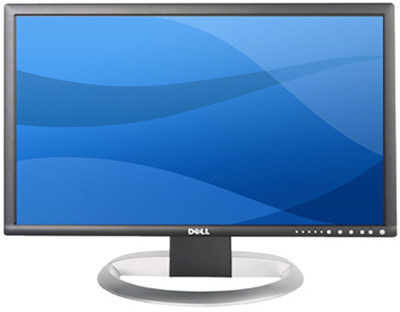Dell 2405FPW, the perfect developer's monitor?

Recently I needed to replace an old 21" CRT which was rapidly failing. The problem is that the CRT was running at 1600x1280 but the typical 19" replacement LCD (like the inexpensive Dell 1905FP) only goes up to 1280x1024, which isn't nearly enough screen real estate. Heck, even some single web pages are starting to be sized for monitors bigger than that. So I tried two 1905FP's in a dual monitor configuration for a while.
This is the same setup I have at home, but it was just cramping my style too much. I spent too much time trying to get windows on the correct monitor, trying to get things sized right, and so forth. I'm a professional developer and my time is valuable to me, and I could justify the extra money for one of the new larger monitors. After some investigation I narrowed it down to two monitors from Dell, the UltraSharp 3007FPW and 2405FPW. (The new 2007WFP might also be an option for you if you don't mind giving up a little resolution.)

Note I wasn't doing this just for the heck of it. Apple recently did a study showing that larger monitors can improve your productivity 40-50% or more, even in very common tasks that have nothing to do with specialized professional applications. ROI was measured at between $5,800-$23,000 per year, depending on salary. For people like me, constantly juggling windows for the IDE, mail, file directories, browsers, terminal windows, and so forth, the increase might even be more.
The 3007FPW is essentially the same monitor as the large Apple 30" cinema monitor, with a slightly better price. While impressive, it has some drawbacks. First, it is over twice the price of the 24" alternative. Second, it has no smarts inside to speak of, and only one input. Finally, it requires dual-link DVI, which would mean a new video card on top of the other expenses. I read all the reviews and got the impression this was a first generation product, whereas the 2405FPW was more seasoned and mature. So in the end, I purchased a new 2405FPW LCD using one of Dell's famous promotional coupons. A few days later, it arrived.
The new 24" LCD works great on my Dell GX620 tower PC. It has a uniform brightness, 5 different inputs, picture-in-picture, slots for camera memory cards and USB connectors, and more. This kind of flexibility is important because I expect to have this monitor for a long time. The only problem I've noticed is that mine has one sub-pixel stuck off, near the bottom of the screen (which is probably not enough to return it).
The native resolution is 1920x1200 but it will scale to lower resolutions if necessary. The power supply is built-in to the monitor (i.e., no 'brick'), and the panel moves up and down or swivels 90 degrees. So far, I'm loving it. This may well be the sweet spot for developers right now.
Currently I have one of the 19" LCDs serving as a second monitor. To go to three monitors would require some more effort. The Dell GX620 motherboard has an on-board analog VGA output, and an adapter card that plugs into the PCI Express slot that exposes a DVI output. Both outputs are controlled by an Intel integrated graphics chip. The motherboard also has two regular PCI slots. As an experiment I tried plugging an nVidia PCI graphics board in one of the PCI slots but I couldn't get all three to be driven reliably.
I did a little research and people recommend that if you do multiple cards, you should buy them from the same vendor. So it might work if I got an inexpensive nVidia PCIe card, like maybe a GeForce6200 TC, to replace the on-board graphics. This system isn't for games so the GPU power is not the primary factor - price and stability is.
So what do you think, is there such a thing as having too much screen real-estate? Are two (or three) smaller monitors just as good or better than one big one?